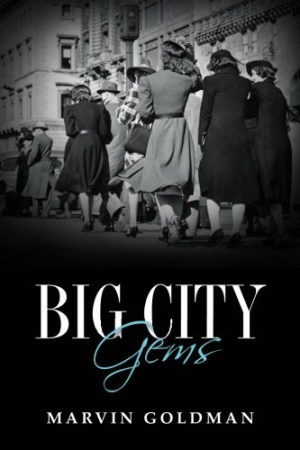Big City Gems
The elegant cover of Big City Gems beguiles with a vintage photograph of fashionable women strolling in a metropolis—an image perfectly suited to Marvin Goldman’s second book, a short story collection on mid-century, primarily Jewish New Yorkers, and a two-act play, set in 1990, on siblings concerned over the challenges of elder care. Whether surveying patrons and staff at a Borscht Belt hotel in the Catskills or locals in the Bronx, the author reveals lives tinged with longing, disappointment, and memories of hardship in Warsaw during the Second World War, but does so with a lighthearted tone.
Selections include two stories about unmatched expectations: “Errol Flynn at Hotel Schneiderman,” an account of a waiter who misinterprets a guest’s seemingly kind but self-centered gesture, and “Could She Be the One?” a casual encounter between Manhattanites. “The Lone Ranger Rides Again” centers around a Jewish mother who ventures beyond her usual boundaries and discovers that her past perception of Christians is gradually dispelled. “The Making of Eddie Bazinski,” “The Benevolent Bookie,” and “My Pal, Sal,” all feature a narrator who relates the escapades of another character.
Goldman, author of the novel My Years in the Womb, frequently introduces characters with external details (attire, physical attributes) rather than subtler gestures, motivations, and psychological complexities. Men and women sometimes emerge as types: protective mothers, a Satyric playboy, a seductive high schooler, and a demanding, wealthy young wife. When Goldman allows readers to draw their own inferences, the characters are more fully realized. For example, his younger narrators exhibit a winsome mixture of naivete and energetic determination.
The collection’s standouts include “When Comic Books were Legal Tender,” which details an afternoon of freedom in the absence of adult supervision. From the opening lines, readers are charmed with alliterative names and the prospect of a dramatic encounter: “Murray Mendlebaum, who had just turned fourteen, had every intention of throwing down the gauntlet, if he had one. Instead, he threw down his first baseman’s glove. Sidney Smilowitz, who was almost the same age, and didn’t have the vaguest idea what a gauntlet was, accepted the challenge by throwing down his catcher’s mitt.”
In “My Haunted Heart,” a ten-year-old, enthralled by his first trip alone, fails to realize that the same day bore sorrow for his mother. Both pieces home in on quieter moments without the bravado found in some of the tales, and modulate the nostalgia that turns stories such as “The Way it Was” into less effective considerations of the period. The concluding play, “The Apron String Quartet,” also deserves mention for infusing appropriate humor into a potentially heartbreaking change.
Big City Gems contains pleasing diversions and promising scenarios that vary in their ability to transport readers to deeper emotional realms. Still, those delighted by New York will appreciate the opportunity to experience Goldman’s interpretation of its historic neighborhoods.
Reviewed by
Karen Rigby
Disclosure: This article is not an endorsement, but a review. The publisher of this book provided free copies of the book and paid a small fee to have their book reviewed by a professional reviewer. Foreword Reviews and Clarion Reviews make no guarantee that the publisher will receive a positive review. Foreword Magazine, Inc. is disclosing this in accordance with the Federal Trade Commission’s 16 CFR, Part 255.

